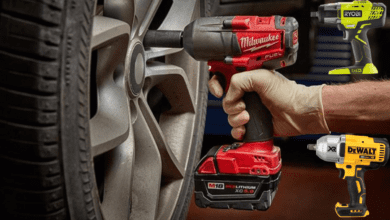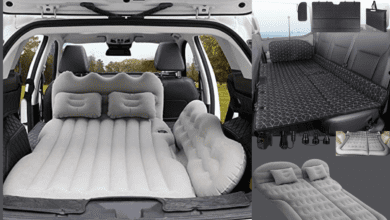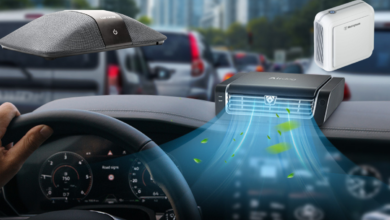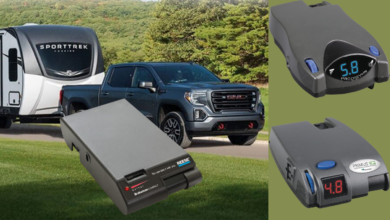Best Durable Floor Jacks of 2023

Best Durable Floor Jacks: You’ll probably need a floor jack, also known as a shop jack if you intend to perform more complicated repairs on your vehicle than cleaning it thoroughly or throwing away those old Starbucks cups. When you need to reach the underneath of your car or remove a tire for maintenance or repairs, floor jacks are beneficial.
However, because floor jacks are designed to suspend one end of a vehicle, which requires raising a significant amount of weight, having the proper one is vital to safety. Floor jacks facilitate this fast and seamless operation.
Because of their sturdier construction, more extensive weight ratings, and bases with broader surface areas for improved stability, floor jacks are far more solid and, thus, safer than the flimsy tiny hand-cranked scissor-type tire changer that usually comes with your car’s spare tire. Their operation is likewise relatively straightforward: they use a long handle to rapidly pump up a pressurized hydraulic cylinder, which elevates a vehicle by lifting a lever mechanism.
Almost every floor jack on the market today can skillfully elevate one corner of a typical automobile or crossover SUV. Different techniques are needed for heavier full-size SUVs, trucks, crossovers, or vehicles with low ground clearance. Even though many different types and sizes of floor jacks are available, we have compiled a brief selection of some of the greatest ones for all your car-raising requirements.
Jack Boss Heavy Duty Steel Service, 3-Ton
BEST ALL-AROUND FLOOR JACK
A well-known tool maker and expert in floor jacks, Torin has a subsidiary called Jack Boss that offers a superb 3-ton floor jack that’s a terrific value for the money. This floor jack is very flexible, with a capacity of up to 6,000 pounds, an 18.3-inch rise height, and 360-degree swivel casters for effortless manoeuvrability. The most significant part is that it’s a great deal at less than $150.
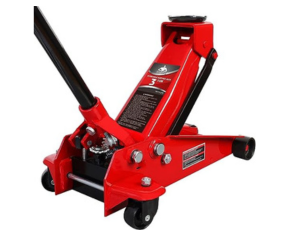
Pros & Cons
- 360-degree swivel casters,
- 18.3-inch lift height,
- and three-ton capacity
- It is not recommended for vehicles with little ground clearance
- The jack saddle has no rubber cushion.
2-Ton Low Rider Steel Service, Sunex 6602LP
BEST LOW-PROFILE, LONG-REACH FLOOR JACK
A jack with a long reach and a low profile is necessary if your automobile is very low and you want to simultaneously elevate both front and back wheels by reaching the jacking point beneath the subframe. (Ac Hydraulics DK13HLQ is the best low-profile long-reach jack; nevertheless, it costs $625.) Much of the same functionality is offered by Sunex but at a more affordable price.
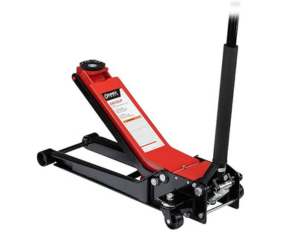
Pros & Cons
- 18-inch horizontal reach,
- low 2.75-inch front profile,
- and 24-inch maximum lift height
- 103 pounds in Weight, 36 inches in length,
- and a large footprint on the floor due to its lack of an integrated rubber cushion
Eight tons/16,000 lbs. BIG RED Welded Hydraulic Bottle Jack
BEST FLOOR JACK, BOTTLE-TYPE
Changing the wheels on a truck or full-sized SUV may be difficult due to their weight and ground clearance, so the jack has to be taller and have more lifting power. This is where bottle-style floor jacks can be helpful. The lift height of the BIG RED Welded Bottle Jack can reach up to 17.63 inches, which is higher than typical lever-style floor jacks.
Even better, it can handle most vehicles and SUVs—aside from those with exceptionally high lift kits—because it is rated up to 8 tons, or 16,000 pounds. In addition, it satisfies ASME and PASE safety requirements, meaning that it may be used for heavy-duty applications, construction, and even for RVs and commercial vehicles.
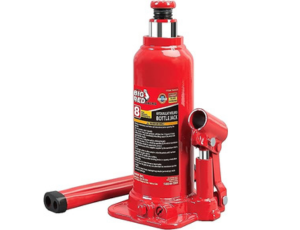
Pros & Cons
- Lift capacity: 8 tons (16,000 pounds);
- maximum lift height: 18 inches
- Attractive and satisfies ASME PASE safety requirements
- There are no wheels for simple moving.
- Some users claim lifting them takes more work than using lever floor jacks.
- A few clients claimed to have received faulty merchandise.
Pro-Lift F-767 2-Ton Low-Profile Floor Jack
BEST VALUE FLOOR JACK
With its low profile, the Pro-Lift F-767 is a good option if you only need a cheap floor jack for occasional garage use to lift one tire at a time. It can even slip under the jacking points on the sides of low automobiles.
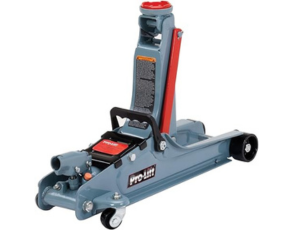
Pros & Cons
- Low cost
- 3.5-inch low profile
- has a bypass valve to avoid over-pumping despite its modest cost
- It only rises to a maximum of 14 inches.
- Reach is limited; it may not be able to raise two wheels off the ground at once.
- lacks an incorporated rubber cushion
Torin Big Red T815016L 1.5-Ton Low Profile Aluminium And Steel Racing Floor Jack
BEST LIGHTWEIGHT FLOOR JACK
A lightweight aluminium floor jack is essential for anybody on a lengthy road trip in an antique automobile or going to a car club track day, where they will be changing tires and wheels. Remember that you are sacrificing capacity and pricing in favour of low Weight. The Torin T815016L costs over $100 and weighs 34 pounds. You may upgrade to the Arcan AL3JT if you need additional capacity, but it costs more than twice as much and weighs 56 pounds.
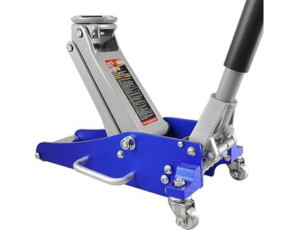
Pros & Cons
- 34-pound Light Weight
- 3.5-inch low profile
- Side grip for simple loading
- One hundred fifty tons, or 3,00 pounds. The lifting capability is relatively low.
- For really low automobiles, reach may not be long enough.
- Not for bigger cars
Torin Big Red T820014S 1.5-Ton Trolley Service/Floor Jack With Case
BEST ON-THE-ROAD TIRE-CHANGING FLOOR JACK
Any floor jack will outperform the little hand-cranked device that comes with your automobile regarding speed and safety. If you only need a small, lightweight jack that fits in a handy plastic carrying box and can raise one tire on your non-Ferrari, non-Hummer, If the Torin T820014S runs out of AAA cell phone range, it should function properly.
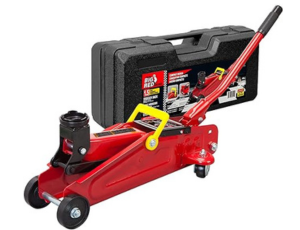
Pros & Cons
- very light (18 pounds)
- incredibly cheap
- carrying case for storage of a rattle-free trunk
- One hundred fifty tons, or 3,00 pounds. The lifting capability is relatively low.
- It is not as stable as a full-sized floor jack due to its small size and posture. Its 5.5-inch front profile may not be able to fit under particularly low automobiles.
Vevor 3-Ton/6,600-Pound Triple Bag Air Jack
Top-Rated Powerful Bag Floor Jack
You’ll value the ease of use of a pneumatic floor jack if you’re lucky enough to own an air compressor at home. Vevor makes one of the most outstanding triple-bag air jacks available right now. All you have to do is use the inbuilt valve to activate after plugging in your air supply.
Rated at 3,600 pounds, 6,600 pounds, or up to 5 tons for the somewhat more costly version, this jack has a lifting clearance of up to 15.75 inches, making it suitable for almost any light-duty vehicle. In addition, it has a large handle, wheels, and a heavy-duty jackpad for more effortless mobility and added security. The one significant drawback is that cars with low seating positions may find it difficult to reach at only 5.5 inches.
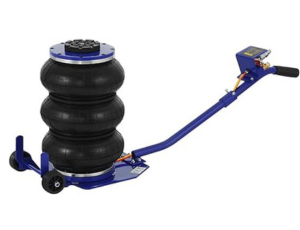
Pros & Cons
- Efficient and simple
- Depending on the model, rated up to 6,600 pounds or 10,000 pounds
- Lifting and lowering quickly
- It is not the best for cars with little ground clearance.
- needs a different air compressor
- Additional conventional floor jacks have a more excellent lifting range.
*************************************
Top 6 Best OBD2 Scanners for 2023: Which is Perfect for You?
You may replace a tire or place the automobile on jack stands for further maintenance by rolling a floor jack underneath the vehicle and raising one wheel or one end. Get a jack that can support one tire up to 33% of the Weight of the automobile. Purchase one rated at 75% of the car’s Weight to raise the front or rear.
With wheel-mounted floor jacks, a portion of the jack is raised by a hydraulic cylinder, representing a part of the vehicle. Modern passenger automobiles seldom fit under bottle jacks. Therefore, they have replaced the traditional kind that used a hydraulic cylinder to elevate the car. On trucks, bottle jacks might still be an affordable option. Anytime a vehicle is lifted, safety must come first. Therefore, jack stands are necessary so the car may be securely parked, and work can be done below.
To avoid over-pumping, a bypass valve is included with every chosen jack. Cost, lift capacity, front profile, lifting height, reach, jack weight, and suitability for the various vehicle categories—passenger car, sports car, and truck—were additional selection factors. Due to their high price and, in many cases, their Weight, professional garages’ usage of commercial-grade supplies was not included.
These weighted measures are the basis on which we assess every floor jack:
- Cost (35%).
- Materials/Quality (15%)
- Maximum Weight (15%)
- Elevation (15%)
- reputation of the manufacturer (10%)
- Unit weight (5%)
- Guarantee (5%)
How much Floorjack do I need in tons?

Obtain a floor jack that can lift at least one-third of the vehicle’s Weight to raise only one wheel. (A half-ton, 0.5-ton jack raises a 3,000-pound, 1.5-ton car’s corner.) Obtain a jack that can support three-quarters of the vehicle’s weight to raise the front or rear (two wheels). Jacks are graded in increments of half a ton.
FAQs
How Should a Floor Jack Be Selected?
The primary consideration is the Weight of your car. A truck jack is required to jack up a truck properly. How low your automobile is comes next. It would be best to have a low-profile long-reach jack to raise an extremely low car’s front or rear wheels. You won’t take any significant, hefty jack kinds on road vacations or to the racetrack.
What Is the Relationship Between the Jack Weight Rating and the Car Weight?
The jack’s entire lifting capability is indicated by its weight rating. The stability of the jack is also influenced by its footprint. Although a bypass valve is a feature of every good jack, you don’t want to overtax them. There are two perspectives on this:
Lifting a single wheel using the (33% rule): The load on the jack is about 25% to 33% of the vehicle’s total Weight. We’ll go with one-third. By this criterion, a 1.5-ton aluminium floor jack or even the tiny trunk-portable 1.5-ton Torin T820014S should be able to raise one wheel without exceeding its limit. For comparison, a 6,500-pound, or 3.25-ton, big SUV weighs one-third the equivalent of 1.08 tons. That is deceptive, however, since it ignores the vehicle’s height and the stability of the jack.
Lifting both front or both back wheels (75% rule): Use a jack rated to at least three-quarters, or 75%, of the vehicle’s weight to raise the front or rear end and raise two wheels off the ground. That means a vast SUV weighing 6,500 pounds and 3.25 tons would need a jack supporting at least 2.4 tons. Getting a floor jack with a capacity of at least 2.5 tons would be best since they are usually rated in half-ton increments.
How Can My Car Be Jacked Up?
Almost every contemporary automobile includes jacking points with plastic pads around the inboard fender corners for each wheel; check your owner’s handbook to ensure. Look for a clear picture of them online if the owner’s manual isn’t clear enough. If your floor jack’s lifting saddle lacks an inbuilt rubber pad, attach one (hockey pucks are a terrific option) and ensure it touches the jack point exclusively.
Pinching a fuel or brake line or tearing a hole in the floor are the last things you want to do. Instead, you must raise the vehicle by a central point on the front or rear subframe to place it on jack stands for repair work. A low-profile, long-reach jack could be necessary to get to such spots on a low automobile.
How Does a Jack’s “Low Profile” Measurement Connect to My Car’s Ground Clearance? Are They Identical?
Though not the same, they are connected. The highest obstacle an automobile can pass over without scratching the undercarriage is known as ground clearance. The height of a jack’s snout above the ground at its lowest setting is known as its profile. When jacking up your automobile, you need to be able to move the jack beneath the vehicle, which means that the shape has to be low enough. The jack’s nose has to fit under the jacking point if you’re only jacking up one wheel.
That jacking point will be lower if the automobile has a flat tire, and you won’t be able to determine the precise measurement until the tire is flat. Things might worsen if the vehicle has a low front air dam (spoiler), and you need to get to a jacking point beneath the front subframe to elevate both front wheels simultaneously. For this reason, you may want a jack with both a long reach and a low profile.
Is It Safe To Work Under a Car Supported Only by a Floor Jack?
Not at all! Before placing any part of your body below the automobile, always put it on adequately rated jack stands. A vehicle supported solely by a jack is often used to replace wheels, but soft asphalt and little inclines may cause a car to tumble off the jack.
Placing the vehicle on stands and keeping the floor jack in place for backup is always safer. Secure wheels with chocks while not in use. One form of car lift that works well for raising an automobile is a hydraulic scissors jack, which glides beneath an automobile and increases the vehicle and all four wheels. Those typically cost between $1,000 and $3,500.
Are Floor Jacks Made of Aluminum Worth It?
Yes, if your goal is a lightweight jack for portability or convenience of movement inside the garage. However, aluminium weighs one-third of steel; steel is more affordable and robust. You will need to purchase a steel jack if you need to use it on a low-rise long-reach or if you drive a big vehicle, such as a truck.
Do I Require Any Other Items?
Sure. To place the automobile on, you may require jack stands. The jack stands’ weight rating must correspond with or surpass the vehicle’s Weight. For cushioning the jack, you may need to purchase rubber jack cushions ($10–$20); hockey pucks also work well. Additionally, wheel chocks are necessary for jacking up the automobile ($10–$30).

